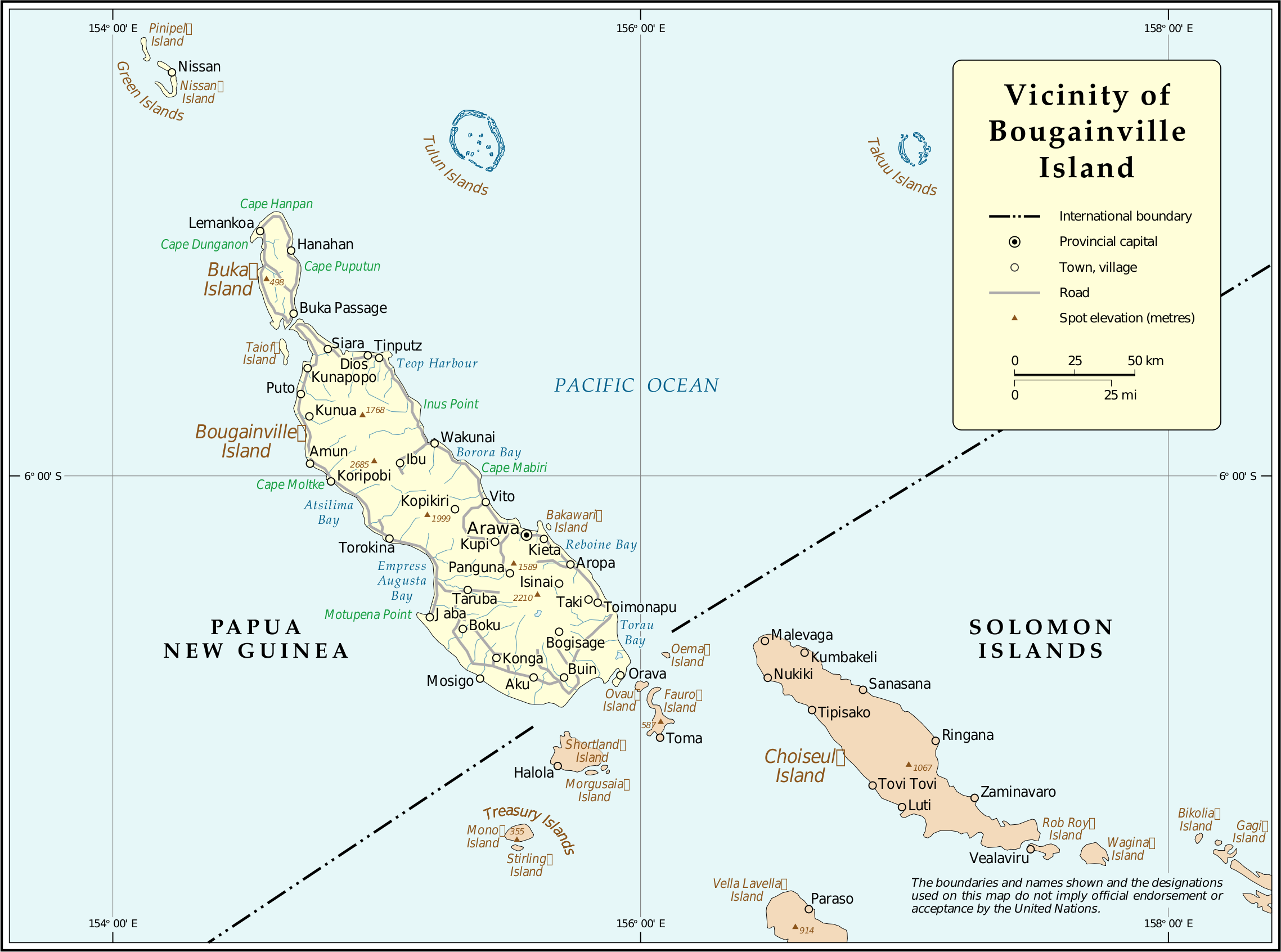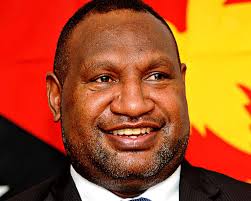by Martin Haffner Associate Editor
Canadian miner Island Passage Exploration (IPX) has announced the beginning of phase four of an exploration programme at Isina in the autonomous Papua New Guinea region of Bougainville.
IPX is poised to take 70 percent ownership of Isina Resource Holdings, a company controlled by local landowners.
The company has been exploring 261 square kilometres in the Crown Prince Range in Central Bougainville, only nine kilometres southeast of the shutdown Panguna mine.
The company behind Panguna, Bougainville Copper Ltd, is looking to reopen the once giant mine, but issues remain about the ongoing environmental and human rights violations blamed on the previous owners.
Don Macdonald interviews {LPL} lead public relations Dan Houston from IPX.
(The transcript has been edited for brevity and clarity.)
Don Mcdonald: So, this prospect at Isina in the centre of Bougainville Island. How did this come about?
Don Houston: I’ll try to make it as brief as possible. After the Peace Accord, it took a long time before Bougainville got to the point where they had a referendum to see how they felt about their future. When they eventually had their vote, it was 98 percent in favour of independence.
The pathway to independence wasn’t going to be an instantaneous thing. There was a goal to maybe get independence by 2027 and that gave the ABG, the Autonomous Bougainville Government, a number of years to work with PNG and other governments to seek their independence. The key to that is, do they have an economy that can support a government?
Right now, most of the funding for the ABG is coming from a transfer payment from the PNG government. A lot of that, in fact, though, is coming from injections of capital from the Australian High Commission and possibly New Zealand, which did play a big role in the peace keeping effort, as you may know.
A colleague of mine who I didn’t know at the time, an Australian-Canadian, moved to the island about 18 years ago, and he’s basically lived there fulltime, working on developing relationships with the Bougainvilleans.
He’s an economist by training, a former director of a Canadian lead zinc mining company called Breakwater. And that man’s name is Lindsay Semple, and he’s lived in Arawa almost continuously, and he has done a lot to work with the customary landowners on the island. In 2015, when the ABG government adopted its own mineral Mining Act, a big component of that Mining Act was the concept that the customary landowners directly own the resources above and below the ground, as opposed to in New Zealand, Australia, Canada, the United States and elsewhere, where governments own the resources on behalf of the people.
That’s rooted in the attitude of the Bougainvilleans that they are never going to be on the receiving end of somebody else exploiting their resources. They want to have co-ownership, co-development rights. So a key tenet of that Mining Act of 2015 which was promulgated as well by the PNG government, is a concept that the locals will always have a 5 percent carried interest to production and the right to participate for a further 5 percent and the ABG government has a right to participate for 20 percent. So built into the Mining Act is the opportunity for the Bougainvillians to have direct ownership of 30 percent of any new mine to be built on the island, in addition to a three- and three-quarter percent royalty, which was payable to the ABG government.
The company behind Panguna, Bougainville Copper Ltd, is looking to reopen the once giant mine, but issues remain about the ongoing environmental and human rights violations blamed on the previous owners.
My colleague, who’s lived there, was working with Sam Kauono in the Arawa area, and they helped the customary landowners in and around Isina to create their own customary landowner created company which obtained the rights for what today we’re calling Exploration Licence No2.
The property covers approximately 260 square kilometres, and our company, Island Passage Exploration has the opportunity to earn into an ownership position from Isina if we spend a certain amount of money and make certain cash payments over the next seven years.
Now, we’ve been in the option for quite a while now, and we’re just ending our first full year. We’ve had crews on the ground since about March 1. We’ve got a team of three geologists who were working with a support crew of approximately 30 Bougainvilleans who have been going out and exploring on the project.
DM: What they’ve been discovering is there are very significant reserves of gold and silver, copper, molybdenum and various other key minerals. Just how much is there do you think?
DH: It’s very early days, Don. We are a long way away from being able to talk about having reserves or resources, and those are very technical terms in the minerals industry. But we have lots of indications that there could be something there. And what’s exciting for a geologist and an exploration company is when Panguna was being put into production, there was a moratorium put in place over the whole rest of Bougainville to prevent any exploration anywhere.
The area outside of Panguna has not been explored, really since 1972. That’s 50 years of no modern exploration going on. So we’ve started at the very beginning, and that’s going out and testing sediments, getting sediment samples from the creeks, covering the project, and anywhere we’re getting some interesting gold or copper, moly, lead, zinc numbers in the stream sediment samples, then we are spending time on the ground, walking up and down the creek beds, maybe doing some soil sampling in those areas to follow up.
The area, like a lot of tropical areas, it’s got incredibly dense foliage, so there’s not a lot of rock outcrop, so you have to do these earlier stage surveys to see where you might find an area of interest. Now what is interesting and a great tool for us is there is a lot of small-scale miners on the whole of Bougainville, and they’re not stupid. They’re very smart in finding places where there is gold.
There’s at least 14 dormant or active small-scale mining operations on our project. So that gives us an indication that if the small miners are finding gold, then maybe there’s something worth following up there. Things are very positive so far, but we have no idea if something might be commercial, and we’re years away from knowing and understanding that at this point.
DM: When you’re exploring, how deep do you go? You’re looking a fair way below the surface, presumably.
DH: We’d like to be. That usually entails drilling holes with a diamond drill. We’re not doing that yet. We’re just collecting samples at surface. The only subsurface sampling we’re doing is with an auger, and we’re going down maybe up to two metres through soil to try to get soil samples closer to bedrock. But we haven’t even gotten to the point where we’ve got a drill target figured out yet. Don.
DM: So, it’s a long, long process. How confident are you at this early stage that you could see it right through and be mining there?
DH: Well explorers are dreamers, and we always think we’re on to the next best thing, no matter where you are in the world. It’s just the nature of what prospecting and geology and mine discovery is all about. The general geological setting of all of Papua New Guinea, the Solomon Islands – it’s in the Ring of Fire, which has a lot of geological reasons why it’s amazingly prospective.
It would be surprising to me at the end of the day, if there’s not more than Panguna on Bougainville, that will be commercially interesting, whether that’s on ELO2 [Exploration Licence No 2] or whether that’s on a different part of the island, that certainly remains to be seen.
DW: And as we know, mining on Bougainville has been a hugely problematic thing, where we’re still working through the legacy of the Panguna Mine. And just this week, a new report out, we have Rio Tinto now saying they will help with remediation and so on. As a result of that, what would be different about your approach to avoid going down that road?
DH: Well, a few things. The way Panguna was permitted and operated, it’s doubtful that that would be permitted today. So just putting your tailings in a river, and this was done normal course of business back then, OK Tedi they put all of their tailings in the river. That simply wouldn’t happen today. And that’s where a lot of the footprint of the former operation is, and it’s very controversial. Our approach is going to be, first, the landowners, we are trying to earn an interest from have a certain degree of control and a certain say in what happens on their land.
We are not going to do something that isn’t done through the lens of a partnership approach. We would take the project through a normal, modern environmental assessment, and see if the impact of building a new mine is acceptable to the people and our shareholders, and most importantly, to the debt world, because you’re never going to be able to borrow money to build a mine unless you can show that your footprint is going to be manageable and you can mitigate negative impacts.
When you look at the range of opportunities from, say, a vein gold mine like K92 [at Kainantu in Eastern Highlands Province] has in Papua New Guinea, your footprint could be very different from an underground mine than a big open pit. What we end up finding at the end of the day on our project, or other people may find elsewhere on the island, remains to be seen, and it’s going to have to be done in a partnership with Bougainville.
They’ve been very clear that mining is going to be a part of their future, but they’re going to be in control, as opposed to when Panguna was permitted in the late 60s. At that time, PNG was a colony still of Australia, and you had the Australian government granting a tenement to an Australian company, and Australia gave them permission to build a mine, and it was done under the standards of the late 1960s and the Papua New Guineans, and especially the Bougainvilleans, had no say in what that looked like.
Because Panguna was so rich, it gave PNG the opportunity to seek independence. They became an independent country two years after operations occurred. But the Bougainvilleans felt very slighted because they were suffering all the environmental impacts from the mine, and very little of the wealth from the mine was staying on Bougainville, it was going to Port Moresby or elsewhere. The Bougainvilleans have set up their Mining Act to ensure that they get their very fair share of any impact from a mine, both positive and negative.
DW: We’ve talked about the landowners company, but your company, IPX, has a substantial holding within that, don’t you? How much is that?
DH: Right now, we own nothing. But we have the opportunity, if we spend 10 million US, we could earn into 70 percent of the project, and making half a million dollars of cash and share payments to that customary landowner company. But if we don’t spend the money and make the payments in the time required under our option agreement, Isina Holdings – the customary landowner company will still own 100 percent of ELO two.
DM: Well, it sounds interesting, and as you say, Bougainville certainly needs something to spark its economy. The prospect of getting back into mining has been talked about a fair bit in the last two or three years, with the prospect of the mine just down the road from you. It’s quite ironic in a lot of ways. It’s just it’s very close, isn’t it?
DH: The border of our project to Panguna is only nine kilometres, and I think there’s an amazing opportunity for Bougainville at Panguna. I’m convinced it’ll be a new mine someday, but right now, I don’t know an exact number, but there’s hundreds, if not 1000s, of people living in the old pit who are doing what we’d call artisanal mining.
Landowner partners and local leaders. Photo: Supplied / Island Passage Exploration
There’s 1000s of people surrounding the pit doing artisanal mining, and any new mining operation at Panguna is going to have to figure out, what do you do with all those people who have been there for a long time, and you’ve got the complexity of Rio Tinto saying they will clean up something from the former impacts. But if you were going to build a new mine, you’re not going to clean up the old mine completely, because that would be duplicative and a waste of money.
If you look at a modern context of mining copper mines, some of them take hundreds of millions of dollars of feasibility work and permitting that can take decades. I’m very optimistic that Panguna will be a new mine someday, but it’s certainly not going to be in the next year or two, because doing a feasibility study on something the size of what people would expect Panguna to be in the future. You’re looking at a five to 10-year period of time, in my opinion.
DM: What are you going to do with your tailings?
DH: Right now, we don’t have a deposit that we’re doing a mine design around and the tail.
DM: What are the ideas, if you’re not going to put them into the river, I mean, you’re on this on the side of a mountain, I understand.
DH: Look, our property goes almost from sea level up to 2000 meters, and then back down. So, we’re straddling a mountain range. If we ended up with a vein gold mine, you’d have a very small footprint and a very small tailings facility.
There’s a modern approach to this called dry stack tailings, where you don’t have, I’ll call it a swimming pool full of the old tailings. And if you look at Batu Hijau in Indonesia, they have a pipe that goes from their mill out into the ocean, and they’re doing what are called submarine tailings disposal.
There is no tailings pond. There’s a wide range of things that you can do, and anything is going to have to be done in concert with what do the customary landowners, what would they like to see happen, and can that be done in an economical way? It is early days for us. We’ve got some tremendous preliminary encouragement of gold, copper, silver, lead and zinc, moly.
We’ve got a lot to work with, but it takes a long time to do these early surveys before you get to the point of drilling. Then even when you’re drilling, there’s no guarantees you’re going to win.
It’s an exciting time, and it’s very interesting to be part of a moment in history where these peoples are grappling with emerging independence and wanting to have an economy of their own. And there’s a lot of challenges on the island, from Buka, the capital, to Arawa where our operations are based out of, the road is about 120 kilometers. It takes the better part of four hours to drive that far, and there’s very little electricity on the island. The people are not poor, like I haven’t seen anybody that’s starving. They live a great life, living off the land, but there’s very little electrification.
There’s a lot of challenges for the island to evolve, and in a lot of remote places where there is little infrastructure, you know, the mining company, if they’re going to build a mine, they end up becoming much more than just a mining company.
We’re making a contribution of buying the materials and flying the materials into one of the remote villages that is not road accessible to help them build a school and a house for a teacher to live in. And you end up doing a lot of things that governments in the West, it would be their domain, but in a place like Bougainville, you end up doing a lot of things to become a good partner with the people.



